

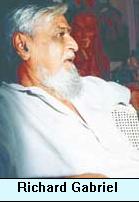 One
needs no special intui-tion to discern that Richard Gabriel’s house in the
tranquil suburb of Pannipitiya, is the abode of an artist. Paints and brushes
are everywhere and more visibly his work, spanning some 50 years is on every
wall. These works, some of them poignant portraits of his family surround him
like old friends, each telling a story of some precious time in his life.
One
needs no special intui-tion to discern that Richard Gabriel’s house in the
tranquil suburb of Pannipitiya, is the abode of an artist. Paints and brushes
are everywhere and more visibly his work, spanning some 50 years is on every
wall. These works, some of them poignant portraits of his family surround him
like old friends, each telling a story of some precious time in his life.
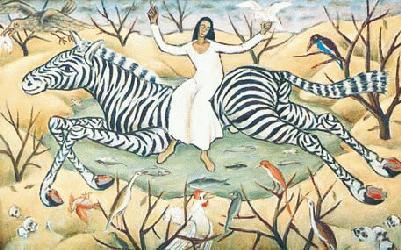 Gabriel’s
work, all of these paintings, some 80 of them and another 50 at the moment in
the hands of private collectors will be displayed to the public at Archbishop’s
House Jubilee Hall, from September 22-24 in an exhibition organised by the
Catholic Church in Sri Lanka. "I held an exhibition of my work last year
and if not for the Archbishop’s prompting, this exhibition would never have
come about,’ says Gabriel diffidently.
Gabriel’s
work, all of these paintings, some 80 of them and another 50 at the moment in
the hands of private collectors will be displayed to the public at Archbishop’s
House Jubilee Hall, from September 22-24 in an exhibition organised by the
Catholic Church in Sri Lanka. "I held an exhibition of my work last year
and if not for the Archbishop’s prompting, this exhibition would never have
come about,’ says Gabriel diffidently.
Richard Gabriel, now in his seventies, was one of the Group of 43 and has vivid memories of a happier time in the august company of Lanka’s most talented, George Keyt, Justin Deraniyagala, George Claessen, Lionel Wendt, W.J G Beling, Ivan Peries and Harry Peiris among them. Those, he says , were the most interesting years of his life. "I think I was lucky to have met the right people at the right time."Having been introduced to Ivan Peries through a mutual friend the young Gabriel then still a schoolboy was encouraged in his work by Ivan, then later channelled by him to Harry Peiris who, he recalls kindly waived any charges and insisted he begin taking lessons at the Sapumal Foundation along with six others. He was the only one to continue with the lessons and then to take his place in the Group of ‘43 in their annual exhibitions. Gabriel recalls a war exhibition which was held in 1942 to which he had submitted some paintings done on old canvases given to him by Ivan Peries. He won some certificates of merit and prize money of Rs 200, a considerable sum at the time.
Gabriel taught for some time at St. Joseph’s but gave it up after a while to concentrate fully on painting. Except for a scholarship to England where he spent an year studying art, his is a talent that has come from within, not schooled much by too much training.
In his early childhood Gabriel lived in Matara before the family moved to Colombo and those early scenes remain in his mind. His mother, who in times when art was not considered a worthwhile vocation encouraged him greatly and later his own wife and family too figure strongly as does the thread of his Christian faith ‘that was always there’. In fact so attached to some of his works, especially those of his family, is he that -he refuses to countenance parting with them."My children are grown up and live abroad now, how can I part with these paintings of them?", he says gesturing in particular at one painting of a young boy on a tricycle (his son). Lionel Wendt was the first to purchase a painting of his. In those days Gabriel sold his early works at sums like Rs 40 for a painting and Rs 15 for a pastel.
Gabriel has always enjoyed working with wood. Some of his best work can be seen in the National Seminary at Ampitiya, but a few of his other efforts in wood will be on display at the exhibition.
Today, he still paints when time permits, but not to any regimented routine. That few people accord this unassuming artist the recognition he deserves, has not blighted his enthusiasm.- RS
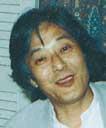 Kiyosho
Fujimoto leaned back in his chair, placing his fingertips together, "movies
are like dreams. There are good ones and bad ones...." He smiled then
added, " the one we will be doing in Sri Lanka will be a good one, I hope."
Kiyosho
Fujimoto leaned back in his chair, placing his fingertips together, "movies
are like dreams. There are good ones and bad ones...." He smiled then
added, " the one we will be doing in Sri Lanka will be a good one, I hope."
Kiyoshi, President of K.K.Fujimoto Productions of Japan was in Sri Lanka last week checking out locations and cast for his latest feature film. Based on the Japanese bombing of Colombo in 1942, the film is expected to be released in time for the 50th independence celebration next February. The film, titled ‘A Time to Remember" will be shot almost entirely in Sri Lanka with a few scenes in Japan. English will be used throughout the movie except in a few clips where Japanese or Sinhala is used.
As yet, the final script is not ready. Japanese script writer Chiho Katsura is remodelling D.B Warnasiri’s original script to suit international audiences as the film is expected to be released worldwide.
Fujimoto was first introduced to the plot by Sri Lankan film producer Jayantha Jayatilaka of Trans Entertainment Services (Pvt) Ltd. Jayatilaka with films like Adara Kathawa and Ganga Addara behind him, brought together Warnasiri and Fujimoto when the latter was in Sri Lanka on other business.
Fujimoto is an acclaimed producer in Japan whose feature films have been oft awarded merit by the Ministry of Education there.
He focuses on human emotions and interactions attempting to depict in his movies not only a story that the public will like but also a social message. "Emotions are universal. People’s feelings do not differ greatly according to country or economic capability," Fujimoto feels. This makes his movies appealing to a mass audience.
As an example, he launched into the story of how Fujimoto Productions turned out their award winning film, "Kenny". Reading a story in the Time magazine on a handicapped boy who uses his arms for mobility, an idea for a script began growing in Fujimoto’s mind. Putting a call through to Pennsylvania, USA where this boy, Kenny, lived Fujimoto was already booking himself on the next flight to the States.
"After long hours of travel, I met the family, and told them "I want to make a movie about Kenny," Fujimoto recollected. Kenny was cast as his role and actors played the other parts. The movie won the Grand Prize at the Montreal International Film Festival.
In his first movie venture here, Fujimoto is attempting to portray "the Sri Lankan mentality’
He said that in Sri Lanka he still sees spirituality existing by the side of rapid modernisation. "A lot of problems have been created because of the Western thinking and even people in those countries are now becoming more spiritual. This will be the new order. Sri Lanka is a good launching pad for a new culture of oriental thinking."
About the film itself, Fujimoto is yet very secretive. "It is not good to reveal too many things too soon," he said. Filming of the movie, expected to begin by October will be mainly in Colombo but places in Galle Weligama and Kandy have also been explored.
Asked how the Japanese audiences will receive the film which is about a World War 11 misdeed attempted by the Japanese Imperial Airforce, both Fujimoto and Katsura said that the people of Japan are truly sorry that such an event occurred.
The cast would also consist 90 percent of Sri Lankans, with several Japanese as co-actors. Final selections are yet to be done. Film director is Yoshishige Yoshida.
In the event that everything goes according to schedule, the movie will be released on February 4, 1998- 50 years since independence. Later in the year it will be released worldwide.
Fujimoto said that he would like to do other projects in the country. When asked if he had any lined up, he said again " there are a hundred dreams but one must proceed slowly."
(Exhibition of recent works of Druvinka at the Heritage Art Gallery, 61, Dharmapala Mawatha, Colombo 3, from 20th to 28th September 1997)
The texture and grain in Druvinka’s work is like a consciousness from which her choices and actions ultimately flow. If Art aims at achieving a full account of the inter-connectedness and cont ingency of human experience and our place in the world, then, in Druvinka’s recent paintings, she has decided to chart one of 20th Century life’s most disturbing territory. The impetus for this subject-matter in these new paintings, she tells me, is her experience of seeing on a T.V. screen this year, the shadowy figures of the Hutu refugees, who fled into the dense forests of Zaire, hidden from view for the most part, by the heavy clouds of the rainy reason and, even the smoke from a neighbouring volcano. These victims of evil, like the "Perethayo" of Sinhala folk lore, have become a constant presence in many societies, this century.
In Druvinka’s renderings of these unfortunates, we are made to observe, with absolute intimacy and yet with a sense of distance and disengagement, these victims of war and hate. In these pictures metaphor and meaning are inseparable. The figures she has created are appropriately two-dimensional, with spidery extremities; sharp, imaciated, jutting, pubes; heads reduced to mere featureless knobs... Everything in these pictures is precise, ‘realistic’, and symbolically charged in a tide of fantasy - something poignantly endearing about these lost people, bending over each other, perhaps alleviated by a faint glimmer of hope, trying to console each other in their misery.
In these pictures Druvinka has demonstrated that she is not one of these artists who prefers to be inward, problematic, obliquely metaphoric, with an investment in obscurity and convolution.
The works at this exhibition are complementary rather than sequential, and seeing them together reveals their basic similarities, but in a way that heightens, rather than reduces, their impact - their near musical power achieved by the devise of repetition and the abilities of theme and variation to spur each other on, perhaps in deference to the aesthetic of Gestalt Psychology, that the totality of visual experience is the fundamental experience.
Druvinka is increasingly a poetically attentive artist. Her figures in these series are adrift in a continuum of dappled white or blue-grey, and grey-red. One way in which she draws our attention to the continuum, as well as her new theme, is to confine this continuum with in frames, which also provides us with a sense of perspective and telescopic distance. Each of these frames, echoing in varying sizes and varying distances, the pictures totality. The colour reduced to two or three, detaches itself from black, grey, red or white. Then together it comes to be recognized as the substance of her art, or a substance which nourishers her art and her pictorial propositions.
These are subtle cerebral works, evincing a kind of cell biology, a molecular existence setting up systems and pictorial organisations that belong with living matter and living things that proliferate and multiply as we look.
Druvinka has always looked for frames and structures for her thought which produces that sense of authority we have now come to associate with her work.
In the paintings at this exhibition, Druvinka seems to have overcome the preoccupation which has led artists and viewers at variance about the meaning of any particular works of art and succeeded in showing that what is visible, and therefore legible on the surface of the canvas, can be taken as a sign of authenticity and truth. This is further reinforced in her paintings, because Druvinka is an entrancing craftswoman; from the canvas and beyond, to the design of the frame, and the proper hanging and illumination of her pictures. Of Druvinka, one could say now - "you can tell a Druvinka painting from a block away" - from her early beginnings, that, seems to have been the point about her talent : "Distinctiveness".
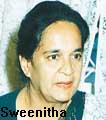
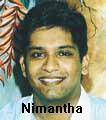 "Inspirations"
is the title of an exhibition of paintings by Sweenitha de Alwis and her son
Nimantha. It is an appropriate title. For Nimantha, the talented son, pointing
to his mother said she was the inspiration for his taking to art.
"Inspirations"
is the title of an exhibition of paintings by Sweenitha de Alwis and her son
Nimantha. It is an appropriate title. For Nimantha, the talented son, pointing
to his mother said she was the inspiration for his taking to art.
Sweenitha has for the last decade showed her many faceted talents in painting. This time one of the pictures that moved me most was a black and white painting of Christ with the Crown of Thorns. Done with so much feeling, it leaves the beholder with an intense feeling of sorrow.
Another painting in black and white of trees in a storm has a startling realism.
Nimantha, an unassuming medical student in his fourth year, loves drama and singing and performs with the Merry-An singers. "I sing semi-classical songs and never pop", he said.
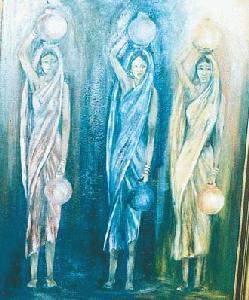 "Painting helps to take my mind away from my medical books and gives me a
respite and an inner feeling of tranquility. As you see out of the fifty
paintings only fourteen are mine. I wish I had more time to paint.’’ "Maybe
in the future I will", he said philosophically.
"Painting helps to take my mind away from my medical books and gives me a
respite and an inner feeling of tranquility. As you see out of the fifty
paintings only fourteen are mine. I wish I had more time to paint.’’ "Maybe
in the future I will", he said philosophically.
His talent is translated well in his paintings of a girl playing a flute, eyes closed with deep concentration.
Two bulls beside a gnarled tree show his desire for detail. There is also a colourful painting of foliage in pleasing colours.
One hopes to see more of his work in the future.
The preview of the exhibition is on September 18th at the National Art Gallery from 4 p.m. to 6 p.m. From the 19th to the 21st the exhibition will be open from 9.30 a.m. to 6 p.m.
![]()
Return to the Plus contents page
![]()
| HOME PAGE | FRONT PAGE | EDITORIAL/OPINION | NEWS / COMMENT | BUSINESS
Please send your comments and suggestions on this web site to
info@suntimes.is.lk or to
webmaster@infolabs.is.lk